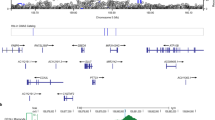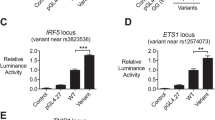Abstract
A recent genome-wide association study revealed a variant (rs2431697) in an intergenic region, between the pituitary tumor-transforming 1 (PTTG1) and microRNA (miR-146a) genes, associated with systemic lupus erythematosus (SLE) susceptibility. Here, we analyzed with a case–control design this variant and other candidate polymorphisms in this region together with expression analysis in order to clarify to which gene this association is related. The single-nucleotide polymorphisms (SNPs) rs2431697, rs2910164 and rs2277920 were genotyped by TaqMan assays in 1324 SLE patients and 1453 healthy controls of European ancestry. Genetic association was statistically analyzed using Unphased. Gene expression of PTTG1, the miRNAs miR-3142 and primary and mature forms of miR-146a in peripheral blood mononuclear cells (PBMCs) were assessed by quantitative real-time PCR. Of the three variants analyzed, only rs2431697 was genetically associated with SLE in Europeans. Gene expression analysis revealed that this SNP was not associated with PTTG1 expression levels, but with the microRNA-146a, where the risk allele correlates with lower expression of the miRNA. We replicated the genetic association of rs2341697 with SLE in a case–control study in Europeans and demonstrated that the risk allele of this SNP correlates with a downregulation of the miRNA 146a, potentially important in SLE etiology.
This is a preview of subscription content, access via your institution
Access options
Subscribe to this journal
Receive 6 digital issues and online access to articles
$119.00 per year
only $19.83 per issue
Buy this article
- Purchase on Springer Link
- Instant access to full article PDF
Prices may be subject to local taxes which are calculated during checkout



Similar content being viewed by others
References
Kontaki E, Boumpas DT . Innate immunity in systemic lupus erythematosus: sensing endogenous nucleic acids. J Autoimmun 2010; 35: 206–211.
Ronnblom L, Alm GV . Systemic lupus erythematosus and the type I interferon system. Arthritis Res Ther 2003; 5: 68–75.
Baechler EC, Batliwalla FM, Karypis G, Gaffney PM, Ortmann WA, Espe KJ et al. Interferon-inducible gene expression signature in peripheral blood cells of patients with severe lupus. Proc Natl Acad Sci USA 2003; 100: 2610–2615.
Baechler EC, Batliwalla FM, Reed AM, Peterson EJ, Gaffney PM, Moser KL et al. Gene expression profiling in human autoimmunity. Immunol Rev 2006; 210: 120–137.
Harley JB, Alarcon-Riquelme ME, Criswell LA, Jacob CO, Kimberly RP, Moser KL et al. Genome-wide association scan in women with systemic lupus erythematosus identifies susceptibility variants in ITGAM, PXK, KIAA1542 and other loci. Nat Genet 2008; 40: 204–210.
Smith VE, Franklyn JA, McCabe CJ . Pituitary tumor-transforming gene and its binding factor in endocrine cancer. Expert Rev Mol Med 2010; 12: e38.
Lu LF, Boldin MP, Chaudhry A, Lin LL, Taganov KD, Hanada T et al. Function of miR-146a in controlling Treg cell-mediated regulation of Th1 responses. Cell 2010; 142: 914–929.
Gangaraju VK, Lin H . MicroRNAs: key regulators of stem cells. Nat Rev Mol Cell Biol 2009; 10: 116–125.
Asli NS, Pitulescu ME, Kessel M . MicroRNAs in organogenesis and disease. Curr Mol Med 2008; 8: 698–710.
Farazi TA, Spitzer JI, Morozov P, Tuschl T . miRNAs in human cancer. J Pathol 2011; 223: 102–115.
Pauley KM, Cha S, Chan EK . MicroRNA in autoimmunity and autoimmune diseases. J Autoimmun 2009; 32: 189–194.
Tsitsiou E, Lindsay MA . microRNAs and the immune response. Curr Opin Pharmacol 2009; 9: 514–520.
Taganov KD, Boldin MP, Chang KJ, Baltimore D . NF-kappaB-dependent induction of microRNA miR-146, an inhibitor targeted to signaling proteins of innate immune responses. Proc Natl Acad Sci USA 2006; 103: 12481–12486.
Luo X, Yang W, Ye DQ, Cui H, Zhang Y, Hirankarn N et al. A functional variant in microRNA-146a promoter modulates its expression and confers disease risk for systemic lupus erythematosus. PLoS Genet 2011; 7: e1002128.
Jazdzewski K, Murray EL, Franssila K, Jarzab B, Schoenberg DR, de la Chapelle A . Common SNP in pre-miR-146a decreases mature miR expression and predisposes to papillary thyroid carcinoma. Proc Natl Acad Sci USA 2008; 105: 7269–7274.
Stark MS, Tyagi S, Nancarrow DJ, Boyle GM, Cook AL, Whiteman DC et al. Characterization of the melanoma miRNAome by deep sequencing. PLoS One 2010; 5: e9685.
Duroux-Richard I, Presumey J, Courties G, Gay S, Gordeladze J, Jorgensen C et al. MicroRNAs as new player in rheumatoid arthritis. Joint Bone Spine 2011; 78: 17–22.
Pauley KM, Satoh M, Chan AL, Bubb MR, Reeves WH, Chan EK . Upregulated miR-146a expression in peripheral blood mononuclear cells from rheumatoid arthritis patients. Arthritis Res Ther 2008; 10: R101.
Li L, Chen XP, Li YJ . MicroRNA-146a and human disease. Scand J Immunol 2010; 71: 227–231.
Ceribelli A, Nahid MA, Satoh M, Chan EK . MicroRNAs in rheumatoid arthritis. FEBS Lett 2011; 585: 3667–3674.
Nakasa T, Miyaki S, Okubo A, Hashimoto M, Nishida K, Ochi M et al. Expression of microRNA-146 in rheumatoid arthritis synovial tissue. Arthritis Rheum 2008; 58: 1284–1292.
Sonkoly E, Wei T, Janson PC, Saaf A, Lundeberg L, Tengvall-Linder M et al. MicroRNAs: novel regulators involved in the pathogenesis of psoriasis? PLoS One 2007; 2: e610.
Balasubramanyam M, Aravind S, Gokulakrishnan K, Prabu P, Sathishkumar C, Ranjani H et al. Impaired miR-146a expression links subclinical inflammation and insulin resistance in Type 2 diabetes. Mol Cell Biochem 2011; 351: 197–205.
Tang Y, Luo X, Cui H, Ni X, Yuan M, Guo Y et al. MicroRNA-146A contributes to abnormal activation of the type I interferon pathway in human lupus by targeting the key signaling proteins. Arthritis Rheum 2009; 60: 1065–1075.
Wang G, Tam LS, Li EK, Kwan BC, Chow KM, Luk CC et al. Serum and urinary cell-free MiR-146a and MiR-155 in patients with systemic lupus erythematosus. J Rheumatol 2010; 37: 2516–2522.
Yue C, Wang M, Ding B, Wang W, Fu S, Zhou D et al. Polymorphism of the pre-miR-146a is associated with risk of cervical cancer in a Chinese population. Gynecol Oncol 2011; 122: 33–37.
Garcia AI, Cox DG, Barjhoux L, Verny-Pierre C, Barnes D, Collaborators GS et al. The rs2910164:G>C SNP in the MIR146A gene is not associated with breast cancer risk in BRCA1 and BRCA2 mutation carriers. Hum Mutat 2011; 32: 1004–1007.
Xu W, Xu J, Liu S, Chen B, Wang X, Li Y et al. Effects of common polymorphisms rs11614913 in miR-196a2 and rs2910164 in miR-146a on cancer susceptibility: a meta-analysis. PLoS One 2011; 6: e20471.
Mittal RD, Gangwar R, George GP, Mittal T, Kapoor R . Investigative role of pre-microRNAs in bladder cancer patients: a case-control study in North India. DNA Cell Biol 2011; 30: 401–406.
Chatzikyriakidou A, Voulgari PV, Georgiou I, Drosos AA . The role of microRNA-146a (miR-146a) and its target IL-1R-associated kinase (IRAK1) in psoriatic arthritis susceptibility. Scand J Immunol 2010; 71: 382–385.
Yang B, Zhang JL, Shi YY, Li DD, Chen J, Huang ZC et al. Association study of single nucleotide polymorphisms in pre-miRNA and rheumatoid arthritis in a Han Chinese population. Mol Biol Rep 2010; 38: 4913–4919.
Zhang J, Yang B, Ying B, Li D, Shi Y, Song X et al. Association of pre-microRNAs genetic variants with susceptibility in systemic lupus erythematosus. Mol Biol Rep 2011; 38: 1463–1468.
Sun LD, Cheng H, Wang ZX, Zhang AP, Wang PG, Xu JH et al. Association analyses identify six new psoriasis susceptibility loci in the Chinese population. Nat Genet 2010; 42: 1005–1009.
Orozco G, Eyre S, Hinks A, Bowes J, Morgan AW, Wilson AG et al. Study of the common genetic background for rheumatoid arthritis and systemic lupus erythematosus. Ann Rheum Dis 2011; 70: 463–468.
Acknowledgements
We gratefully acknowledge the financial support provided through the BIOLUPUS Research Networking Programme of the European Science Foundation. This work has been supported by the Swedish Research Council to MEAR, the King Gustaf Vth-80th Jubilee Fund to SVK and MEAR, Clas Groschinskys Fund and Olle Engkvist Byggmästare Fund and Marcus Borgström Fund to SVK and the Swedish Association Against Rheumatism to SVK and MEAR. Dr Pons-Estel's work was supported by the Federico Wilhelm Agricola Foundation Research grant. Dr Torsten Witte's work was supported by DFG WI 1031/6-1. We also acknowledge the Instituto de Salud Carlos III (PS09/00129) partly co-financed through European FEDER funds, Spain.
Author information
Authors and Affiliations
Corresponding authors
Ethics declarations
Competing interests
The authors declare no conflict of interest.
APPENDIX
APPENDIX
The list of participants
The Argentine Collaborative Group Participants are Hugo R Scherbarth MD, Pilar C Marino MD, Estela L Motta MD, Servicio de Reumatología, Hospital Interzonal General de Agudos ‘Dr Oscar Alende’, Mar del Plata, Argentina; Susana Gamron MD, Cristina Drenkard MD, Emilia Menso MD, Servicio de Reumatología de la UHMI 1, Hospital Nacional de Clínicas, Universidad Nacional de Córdoba, Córdoba, Argentina; Alberto Allievi MD, Guillermo A Tate MD, Organización Médica de Investigación, Buenos Aires, Argentina; Jose L Presas MD Hospital General de Agudos Dr Juán A Fernandez, Buenos Aires, Argentina; Simon A Palatnik MD, Marcelo Abdala MD, Mariela Bearzotti PhD, Facultad de Ciencias Medicas, Universidad Nacional de Rosario y Hospital Provincial del Centenario, Rosario, Argentina; Alejandro Alvarellos MD, Francisco Caeiro MD, Ana Bertoli MD, Servicio de Reumatología, Hospital Privado, Centro Medico de Córdoba, Córdoba, Argentina; Sergio Paira MD, Susana Roverano MD, Hospital José M. Cullen, Santa Fe, Argentina; Cesar E Graf MD, Estela Bertero PhD Hospital San Martín, Paraná; Cesar Caprarulo MD, Griselda Buchanan PhD Hospital Felipe Heras, Concordia, Entre Ríos, Argentina; Carolina Guillerón MD, Sebastian Grimaudo PhD, Jorge Manni MD Departamento de Inmunología, Instituto de Investigaciones Médicas ‘Alfredo Lanari’, Buenos Aires, Argentina; Luis J Catoggio MD, Enrique R Soriano MD, Carlos D Santos MD, Sección Reumatología, Servicio de Clínica Medica, Hospital Italiano de Buenos Aires y Fundación Dr Pedro M Catoggio para el Progreso de la Reumatología, Buenos Aires, Argentina; Cristina Prigione MD, Fernando A Ramos MD, Sandra M Navarro MD Servicio de Reumatología, Hospital Provincial de Rosario, Rosario, Argentina; Guillermo A Berbotto MD, Marisa Jorfen MD, Elisa J Romero PhD Servicio de Reumatología Hospital Escuela Eva Perón. Granadero Baigorria, Rosario, Argentina; Mercedes A Garcia MD, Juan C Marcos MD, Ana I Marcos MD, Servicio de Reumatología, Hospital Interzonal General de Agudos General San Martín, La Plata; Carlos E Perandones MD, Alicia Eimon MD Centro de Educación Médica e Investigaciones Clínicas (CEMIC), Buenos Aires, Argentina; Cristina G Battagliotti MD Hospital de Niños Dr Orlando Alassia, Santa Fe, Argentina.
The Italian collaborative participants are Nadia Barizzone (Department of Medical Sciences, University of Eastern Piedmont, Novara, Italy), Maria Giovanna Danieli (Dipartimento di Scienze Mediche e Chirurgiche, Università Politecnica delle Marche, Ancona, Italy), Gian Domenico Sebastiani (U.O.C. di Reumatologia Ospedale San Camillo, Roma, Italy), Enrica Bozzolo, Maria Grazia Sabbadini (IRCCS San Raffaele Hospital, Milan, Italy), Mauro Galeazzi, (Siena University, Siena, Italy), Sergio Migliaresi, Giovanni La Montagna (Rheumatology Unit Second University of Naples, Naples, Italy).
Rights and permissions
About this article
Cite this article
Löfgren, S., Frostegård, J., Truedsson, L. et al. Genetic association of miRNA-146a with systemic lupus erythematosus in Europeans through decreased expression of the gene. Genes Immun 13, 268–274 (2012). https://doi.org/10.1038/gene.2011.84
Received:
Revised:
Accepted:
Published:
Issue Date:
DOI: https://doi.org/10.1038/gene.2011.84
Keywords
This article is cited by
-
Interpretable machine learning identifies paediatric Systemic Lupus Erythematosus subtypes based on gene expression data
Scientific Reports (2022)
-
Genetic variants of microRNA-146a gene: an indicator of systemic lupus erythematosus susceptibility, lupus nephritis, and disease activity
Molecular Biology Reports (2020)
-
miR-146a rs2431697 identifies myeloproliferative neoplasm patients with higher secondary myelofibrosis progression risk
Leukemia (2020)
-
MicroRNA-146a rs2910164 is associated with severe preeclampsia in Black South African women on HAART
BMC Genetics (2017)
-
MicroRNA-146a reduces MHC-II expression via targeting JAK/STAT signaling in dendritic cells after stem cell transplantation
Leukemia (2017)



